Adoption and Use
Survey of Illinois Households Examines Broadband Usage, Benefits, Barriers
 In a multi-faceted survey released in early 2013 by Broadband Illinois, Illinois households rated fiber-optic internet connections highest in terms of speed, reliability and value. However, households in rural and isolated areas of Illinois are almost four times as likely to have a dial-up connection.
In a multi-faceted survey released in early 2013 by Broadband Illinois, Illinois households rated fiber-optic internet connections highest in terms of speed, reliability and value. However, households in rural and isolated areas of Illinois are almost four times as likely to have a dial-up connection.
This survey was conducted in 2012 and had over 2,129 responses from individual households. Diverse geography as well as community population both seemed to be a major part in the network quality and availability that was provided. Respondents cited lower-quality connectivity as a major negative impact on a household’s internet productivity, including online education, telework, home businesses and accessing the workplace.
See Full Article Here...
The full reports are available for download below.
Download the "Broadband Illinois eSolutions Benchmarking Report" here.
Download the "Broadband Illinois eStrategy Report" here.
BROADBAND ADOPTION IN ILLINOIS:
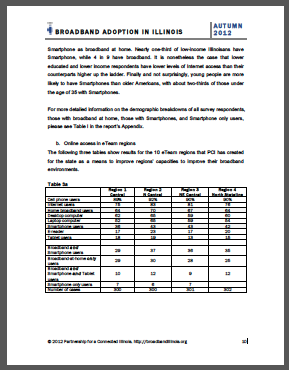 Who is online, who is not, and how to expand home high-speed adoption
Who is online, who is not, and how to expand home high-speed adoption
The digital divide prevails in areas of Southern and Western Illinois where less than 60 percent of residents use high-speed internet services at their home, according to a report on broadband adoption and usage released today by Broadband Illinois.
Identifying who has high-speed internet, who doesn’t, and how broadband adoption can be expanded to more Illinois homes are key themes of the research, which was gathered via a phone survey in the first quarter of 2012. The report is unique in that it provides a regional breakdown of broadband adoption and usage patterns and cites reasons why some Illinois households choose not to have broadband at home.
“Our ten regional eTeams are poised to address the differences in broadband usage in each area of the state,” said Drew Clark, Executive Director of Broadband Illinois. “This exciting research provides new insights, at a regional level, that we’ve never before had access to.”
This first-of-its-kind report for Illinois was led by premier broadband researcher, John Horrigan, Ph.D., who worked for nine years as a director at the Pew Internet & American Life Project, helped author the Federal Communications Commission’s (FCC’s) National Broadband Plan, and designed and conducted the FCC’s first national survey on broadband adoption and usage. Horrigan currently directs the Media & Technology Institute at the Joint Center for Political and Economic Studies in Washington, D.C
Because Broadband Illinois commissioned a separate research initiative concentrated on the City of Chicago, today’s report focuses on areas of Illinois outside of Cook County.
The report also provides significant detail on smartphone usage. Smartphones are cited as a “strong foothold” in how people in Illinois access the internet. Some 46 percent of Illinois residents have a smartphone, and adoption rates are particularly prevalent for African American and Hispanic users.
Other key findings of the report:
- 68% of Illinois adults surveyed have broadband at home; 56% of African Americans and 56% of Hispanics have broadband at home.
- There is significant regional variation in home broadband adoption rates. For example, in four eTeam regions- Northwest, Southeast Central, Southern, and West Central- home broadband rates fall below 60%.
- The 32% of Illinois adults without broadband at home are older, more rural, and have lower incomes than broadband users in the state. Cost, relevance, and digital literacy are cited as key reasons people do not have broadband.
To download the full “Broadband Adoption in Illinois” report, click here.
Barriers to Broadband Adoption in Illinois 
The map on the right shows the percent of unserverved and underserved in each of the Illinois counties. The percent in red shows the percent of occupied households with no broadband service. The percent in orange shows the percent of occupied households that is underserved. Broadband Illinois defines an area as being "underserved" as areas having the maximum advertised download speeds of less than 3 mbps.
The analysis for this map removes cellular and satellite providers and only condiders download speeds.
To download the table for this map, click here.
The maps below demonstrate our ability to connect variables, maps, and visuals together in understanding the digital divide. The following map communicates early indicators of the demographic and geographic expression of the digital divide in Illinois. This map includes four variables: age, income, education attainment, and race. In some areas of the State you will see 2-3 of them present in the same region.
Data: 2010 Census Projections (ESRI)
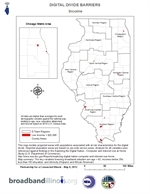 Low Incomes
Low Incomes
Census block groups with median family incomes < $25,000
Click here to view full map.
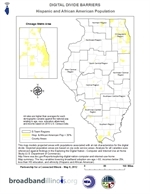 Race
Race
Hispanic and African American Population zips with at least 58% of the population (double the national rate)
Click here to view full map.
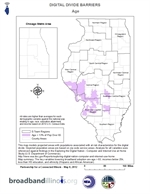 Age
Age
Zips with over 13% of the population over 65 (National Average = 13%)
Click here to view full map.
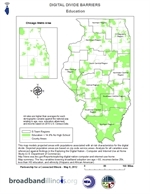 Education Attainment
Education Attainment
Zips with over 14.6% of the population with less than a high school education (National Average)
Click here to view full map.
NIU Broadband Survey Report: The Use of Broadband and Demand for iFiber Among Community Anchor Institutions
Northern Illinois University (NIU) and its Regional Development Institute have, for many years, played a leading role in advancing broadband connectivity throughout Illinois. One of NIU’s initiatives includes active involvement in two Broadband Technology Opportunities Program (BTOP) grants. One grant was received by DeKalb County but NIU information technology network design staff was involved in the development of the proposal and in the implementation of the project. This project, the DeKalb Advancement of Technology Authority (DATA), will result in a broadband network in DeKalb County, Illinois. The second project includes nine counties in northwest Illinois and the grant was received by NIU with Illinois Fiber Resources Group (iFiber) being a sub-recipient.
Survey results in brief are available, as well as the full report.